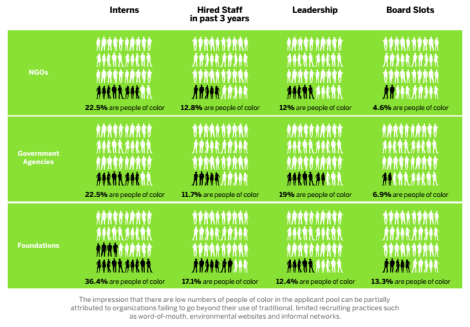President John F. Kennedy once told an audience of American University grads, “We can help make the world safe for diversity. For in the final analysis, our most basic common link is that we all inhabit this small planet. We all breathe the same air.”
That was 1963. We did not inhale the same oxygen then, and we certainly don’t now. In 2011, scientists found that American counties with the worst levels of ozone had significantly larger African-American populations than counties with less pollution. A recent study from the University of Minnesota found that black and brown Americans are more often trapped in neighborhoods laden with nitrogen dioxide than their white fellow Americans.
And despite civil rights laws, organizations whose mission is to clean the air don’t seem to have grown much more hospitable to people of color. A new report, released today, shows that the staffs of mainstream green groups have been overrepresented with white men despite the groups’ intentions to be more colorful. One of its most damning findings is that “the dominant culture of the organizations is alienating to ethnic minorities, the poor, the LGBTQ community, and others outside the mainstream.”
The report, called “The State of Diversity in Environmental Organizations,” is billed as “the most comprehensive report on diversity in the environmental movement.” It was compiled by a working group of thought leaders on environment and race called Green 2.0, led by University of Michigan professor Dorceta Taylor. The report explores the history of tension between green activism and racial justice, and the many attempts at rapprochement.
From Earth Day 1970 until today, the report says, the majority of the people directing, staffing, and even volunteering at green groups have not only been white men, but they also hail from wealthier households with elite educational pedigrees. A 1972 study of 1,500 environmental volunteers nationwide showed that 98 percent of them were white and 59 percent held a college or graduate degree. Compare that to Taylor’s more recent demographic profiling of environmental orgs where, based on data collected on 166 mainstream organizations from 2004 to 2006, she found that minorities comprised just 14.6 percent of their staffs.
People of color make up 37 percent of the U.S. population today. Census figures predict that white Americans will no longer be the majority as early as 2043.
The most recent data on people of color hired by green organizations is reflected in this infographic below, from the Green 2.0 report:
The report also found a gap between white environmental leaders’ desires and their actions when it comes to diversity. Of the near-300 people surveyed — from major environmental groups, foundations, and federal environmental agencies — 70 percent expressed interest in ideas to include more people of color and low-income in the workforce, but only 50 percent of environmental org and foundation members said they’d actually act on such ideas if proposed. For federal government agencies, it was 40 percent.
This is far from the first indictment of the environmental movement on this front, but the Green 2.0 group says it plans to hold the movement accountable. Its recommendations for finally moving the needle on this problem include creating diversity assessment plans with transparency for tracking progress, and increasing resources for diversity initiatives (one finding of the report is that not one green foundation has a diversity manager).
More on this later throughout the week as I make my way through the rest of the report, which you can find at the Green 2.0 website.




